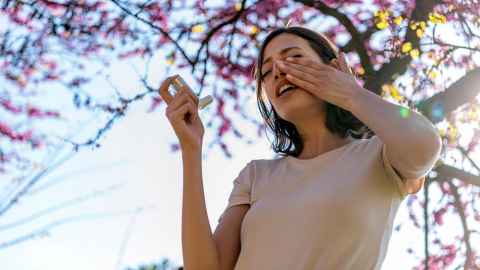Seven tips to combat seasonal allergies
6 November 2023
Dr Amy Chan has seven tips to combat seasonal afflictions.

While warm temperatures and blooming flowers are great news for outdoor activities, a change in season can bring an increase in people’s allergy symptoms.
Seasonal allergies – including hay fever and allergic eye conditions – affect more than one third of the population and are caused by pollen allergens commonly found in the air. With climate change, the pollen season is arriving earlier and staying longer, meaning we are likely to see an increase in such allergies, and a longer period of suffering for those with them. Here are Amy Chan's seven tips, with help from Allergy New Zealand.
1. Recognise what you have
Some allergy symptoms can be mistaken for something else, such as a cold or ’flu. If you have a runny nose, sneezing, itchy eyes, nose or throat for longer than a couple of weeks, you need to identify the cause (read on!). Allergies can start even if you’ve not had them before. Check in with your doctor.
2. Find your triggers
The triggers for seasonal allergies vary from person to person, and one month to another. Tracking your symptoms can be useful to get an idea of when they are worst so you can work out what you may be allergic to. If your symptoms tend to come on early spring, your main trigger may be tree pollen. In late spring and early summer, grass pollen tends to be highest, while in late summer, weed pollens may be your trigger. If you have symptoms all year round, you may be affected by allergens inside your home, work or school environment rather than outdoor triggers.
3. Protect yourself
While you may not know for sure what your triggers are, there are simple steps to help reduce your exposure to potential allergens. Some ideas include staying indoors on dry, windy days when pollen levels can be high. If you do need to be out, wear a mask or face covering, sunglasses and a hat, and tie up long hair. Pollen levels are highest between 5am and 10am, so keeping windows closed and going out later in the day can reduce exposure. When driving, shut your vents and recirculate interior air, or turn on air conditioning. If you have bad symptoms after being outside, it’s worth changing your clothes to avoid bringing pollen inside. Your body and hair can collect pollen, so shower at night to keep pollen from your bed.
4. Your home, your castle
Some people are triggered by indoor allergens like dust mites, moulds, animal dander, and cockroaches. Keeping your house clean and decluttered helps because clutter accumulates dust. If you’re sensitive, wear a mask and gloves and use allergy-friendly products, particularly if you have a chemical sensitivity, eczema or asthma. It goes without saying that regular vacuuming and dusting can remove allergens from your surfaces, but if you can afford it, invest in air conditioning with a high-efficiency particulate air (HEPA) filter too. It will reduce circulating allergens including mould, dust and pollen. It’s also worth removing your shoes at the door to avoid bringing in allergens, and keeping indoor air dry with a dehumidifier.
While you may not know for sure what your triggers are, there are simple steps to help reduce your exposure to potential allergens.
5. Try anti-allergy medication
If allergic rhinitis (hay fever) is affecting your quality of life, and/or you also have asthma, a doctor can prescribe intra-nasal corticosteroid sprays, allergic eye drops and anti-histamine tablets. These are also available over-the-counter in pharmacies. If possible, start taking your medication(s) as prescribed two weeks before the allergy season is expected to start. That can help reduce your sensitivity to pollen triggers.
6. Hydrate
As part of your body’s allergic response, allergens can trigger nasal swelling and congestion, and non-stop nose blowing. Drinking water and keeping well hydrated helps to thin the mucus in your nose. Saline nasal sprays or irrigation solutions from the pharmacy can help loosen up mucus and wash out any allergens trapped in your nose.
7. Sleep easy
First, take any antihistamine before bed. Allergy symptoms can feel worse at night, and can be caused by pollen on our clothes or bedding. Wash bedding regularly, ideally in hot water over 60°C. Throw a spare sheet over your bed during the day to protect your bedding from allergens. If you can, avoid hanging laundry outside, as pollen can stick to sheets and clothing. And (sorry, pets) try to keep animals out of the bedroom.

This column, part of the regular Ingenio feature 7 Tips, appears in the Spring 2023 issue.
The tips were written with the help of Allergy New Zealand.